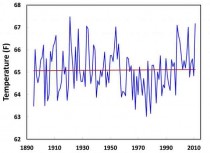By Forrest Mims III, For the Express-News
In the early days of this column, concerned readers sent many questions about the earth’s ozone layer, which I began measuring in 1990. Today, public interest in the ozone layer has been replaced by concern about global warming.
Answering questions about global warming requires considerably more space than this 437-word column. So let’s focus in on the temperature history of Texas for now.
The 2011 Texas drought was exacerbated by the highest temperatures since 1895 during June, July and August. Several prominent climate scientists have blamed these record highs on global warming. These claims are puzzling because, in spite of the 2011 record highs, Texas records going back more than a century show slightly more cooling than warming. So I visited the National Climatic Data Center website to review Texas temperature records. The NCDC provides monthly temperature records for 10 Texas regions going back to 1895.

Enlarged
It also provides the average temperature for the entire state.
I retrieved all 12 months of data for each year since 1895 and plotted the average annual temperatures on a chart along with their trend. As shown in the chart, the average temperature of Texas barely changed between 1895 and 2011. The total warming during those 116 years was a statistically insignificant 0.046 degree Fahrenheit. If the record highs of 2011 are omitted, Texas cooled 0.055 degree from 1895 to 2010.
The NCDC temperature data do not fully account for the enhanced warming of weather stations that have become surrounded by buildings and pavement. This is the heat island effect. Dr. Daniel Boice of the Southwest Research Foundation studied the temperature at New Braunfels and San Antonio from 1946 to 1990.
He found that San Antonio has warmed when compared with its smaller neighbor. San Antonio might be several degrees cooler today than in 1885 if no new buildings and roads had been constructed. Why do some scientists insist that Texas is warming when the data show a negligible increase? I don’t know. But I do know that a National Science Foundation program officer told me that applications for atmospheric science grants that do not include a global warming theme stand little chance of acceptance.
Climate scientists are right to be concerned about droughts, especially since no Texas drought since precipitation records were begun around 1870 matches the megadroughts revealed in the rings of bald cypress trees. Those droughts occurred hundreds of years before SUVs and power plants began pumping carbon dioxide into the atmosphere, a process blamed for global warming that has not yet arrived in Texas.
Forrest Mims III, an expert reviewer for the Intergovernmental Panel on Climate Change, was named one of the 50 Best Brains in Science by Discover Magazine. His science is featured at http://www.forrestmims.org. Email him at forrest.mims@ieee.org.
Read more.
Author Note:My latest science column was on how the State of Texas has not warmed from 1895 through 2011, and I’m already dealing with a rather vicious hate mail and some warmists who are quite upset that I am denying global warming. The column was only about Texas, but that didn’t matter.
You can’t deny their religious beliefs. Data doesn’t matter. Ideology and theory and models only count to the believers. See this tragic example of another apocalyptic movement that led to a lost civilization.
---------------
Morocco’s Green dream fails climate test
Africa review
An unprecedented cold spell that struck Morocco in February and continues to linger well into March has raised serious questions about the country’s national agricultural development programme, which will fail to achieve its desired results if climate change continues to be mismanaged.
The ‘Green Morocco Plan’ was launched last year with the aim of remedying major obstacles that still hinder development of the agricultural sector, tackling everything from ensuring food security for 32 million Moroccans, to meeting the requirements of European markets, the biggest consumers of Moroccan produce.
However, the Plan does not do a thorough job of diagnosing climate factors, citing only drought, which it considers ‘periodical’, as an impediment to successful farming. The report does not address the sudden and unexpected arrival of cold weather, whose damages have been no less than disastrous.
Last February, more than 8,200 of the country’s 8,700 hectares of potatoes, were ravaged. A further 14,000 of about 21,000 hectares reserved for sugarcane were also blighted by the cold. This is particularly significant since potatoes and sugar are two of Morocco’s primary export commodities.
“We have never seen such a degree of cold. All that we worked for was completely destroyed,” Ahmed El Aiboudi, a farmer from the Ouled Frej region, 120 kilometres south of Casablanca, said.
“We were not protected against this icy cold. Nobody expected it,” he added. Nevertheless, for climatologists, such changes have been inevitable.
Mohammed-Said Karrouk, professor of climatology at Hassan II Mohamedia University and a United Nations expert on climate change, told IPS, “The Green Morocco Plan does not contain any (concrete mention of) management of climate change. All that is considered is the management of water resources, (but what is really needed) is a method for managing the totality of the changes




